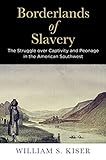Borderlands of Slavery : The Struggle over Captivity and Peonage in the American Southwest / William S. Kiser.
Material type: TextSeries: America in the Nineteenth CenturyPublisher: Philadelphia : University of Pennsylvania Press, [2017]Copyright date: ©2017Description: 1 online resource (280 p.) : 16 illusContent type:
TextSeries: America in the Nineteenth CenturyPublisher: Philadelphia : University of Pennsylvania Press, [2017]Copyright date: ©2017Description: 1 online resource (280 p.) : 16 illusContent type: - 9780812249033
- 9780812294101
- Forced labor -- New Mexico -- History -- 19th century
- Indian captivities -- New Mexico -- History -- 19th century
- Indian slaves -- New Mexico -- History -- 19th century
- Peonage -- New Mexico -- History -- 19th century
- Reconstruction (U.S. history, 1865-1877) -- New Mexico
- American History
- American Studies
- HISTORY / United States / 19th Century
- 306.3/620978909034 23
- HD4875.U5 K57 2017eb
- online - DeGruyter
- Issued also in print.
| Item type | Current library | Call number | URL | Status | Notes | Barcode | |
|---|---|---|---|---|---|---|---|
 eBook
eBook
|
Biblioteca "Angelicum" Pont. Univ. S.Tommaso d'Aquino Nuvola online | online - DeGruyter (Browse shelf(Opens below)) | Online access | Not for loan (Accesso limitato) | Accesso per gli utenti autorizzati / Access for authorized users | (dgr)9780812294101 |
Frontmatter -- Contents -- Prologue -- Introduction -- Chapter 1. Debating Southwestern Slavery in the Halls of Congress -- Chapter 2. Indian Slavery Meets American Sovereignty -- Chapter 3. The Peculiar Institution of Debt Peonage -- Chapter 4. Slave Codes and Sectional Favor -- Chapter 5. Reconstruction and the Unraveling of Alternative Slaveries -- Conclusion -- Notes -- Bibliography -- Index -- Acknowledgments
restricted access online access with authorization star
http://purl.org/coar/access_right/c_16ec
It is often taken as a simple truth that the Civil War and the Thirteenth Amendment to the Constitution ended slavery in the United States. In the Southwest, however, two coercive labor systems, debt peonage-in which a debtor negotiated a relationship of servitude, often lifelong, to a creditor-and Indian captivity, not only outlived the Civil War but prompted a new struggle to define freedom and bondage in the United States.In Borderlands of Slavery, William S. Kiser presents a comprehensive history of debt peonage and Indian captivity in the territory of New Mexico after the Civil War. It begins in the early 1700s with the development of Indian slavery through slave raiding and fictive kinship. By the early 1800s, debt peonage had emerged as a secondary form of coerced servitude in the Southwest, augmenting Indian slavery to meet increasing demand for labor. While indigenous captivity has received considerable scholarly attention, the widespread practice of debt peonage has been largely ignored. Kiser makes the case that these two intertwined systems were of not just regional but also national importance and must be understood within the context of antebellum slavery, the Civil War, emancipation, and Reconstruction.Kiser argues that the struggle over Indian captivity and debt peonage in the Southwest helped both to broaden the public understanding of forced servitude in post-Civil War America and to expand political and judicial philosophy regarding free labor in the reunified republic. Borderlands of Slavery emphasizes the lasting legacies of captivity and peonage in Southwestern culture and society as well as in the coercive African American labor regimes in the Jim Crow South that persevered into the early twentieth century.
Issued also in print.
Mode of access: Internet via World Wide Web.
In English.
Description based on online resource; title from PDF title page (publisher's Web site, viewed 26. Aug 2020)


